As an unreformed boat building addict, I have added to my afliction. Boats, boats, boats, they are everywhere. Two in the yard and two in the shed and more ideas everyday on Duckworks. This year marked my Ruby (40th) anniversary with my bride. A boat named Ruby screamed to be built.
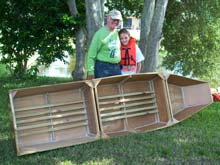 |
As an unreformed boat building addict, I have added to my afliction. |
Duckworks began to market the plans of a genius named Ken Simpson, who designed and built Toter and the EZ Nesting Canoe. The boat building gods must have aligned these events for a reason. I could see combining these great boats into one.
First each section could weigh up to 40 pounds. I can still lift 40 pounds. Second, if the middle section was 48 inches and the stern section was 42 inches and the bow section was 36 inches. The boat was 10-1/2 feet long and stacked inside each other would fit inside the back of my small pickup with a camper top.
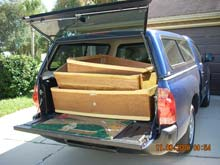 |
The boat was 10-1/2 feet long and stacked inside each other would fit inside the back of my small pickup with a camper top. |
My Ruby is an Elegant Punt version of Ken Simpson’s canoe. The middle section was first. It was 48 inches long including the splines which lock the parts together. The Mid Frame was 32” at the gunnel and 28” on the bottom. The ends were 31” at the top and 26” at the bottom. The splines were 1x4 cut in half on a 45% angle. I took another page from Ken Simpson and used lots of Titebond III along with my old stand-by, PL Premium. The two glues are the opposite in viscosity but work well. I used Luan plywood because it is light and I am cheap. I sealed the clay fill-ins in the Luan with the Titebond. I ripped the gunnel and bottom strips from 2x4’s. I used furring strips to make a front-to-back seat in the middle and stern sections.
| The middle section was 48 inches long including the splines which lock the parts together. |
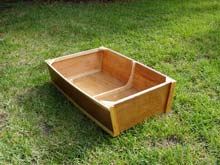 |
The bow and stern sections meet the mid section with matching dimensions. The stern section is 42” in length. The bow transom and the rear transom are sandwiches of Luan and furring strips. First the pattern for each section was laid out on Luan. The furring strips outlined the pattern using Titebond. This was cut out as it dried and a top section of Luan was set in Titebond.
 |
The bow and stern sections meet the mid section with matching dimensions. |
The front transom is 18” high and 12” across at bottom and top. The rear transom is 18” high with a handle set in at the top. It is 24” at the bottom and 28” at the gunnel angling up to the handle. I made a wooden handle for the bow and screwed it on the front transom.
| I made a wooden handle for the bow and screwed it on the front transom. |
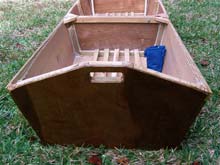 |
First trials were run using hook and eye fasteners. The bow section wanted to float up and away. The hook and eyes were replaced with 5/16” bolts and wing nuts. This makes for a rigid canoe that tracks well. With a 75 pound beauty in the stern and a 190 pound granpa in the middle, Ruby drew about 3”.
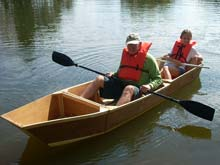 |
With a 75 pound beauty in the stern and a 190 pound granpa in the middle, Ruby drew about 3”. |
I have rigged up a simple canoe sail with two 4 foot pieces of PVC and a small piece of polytarp. Pipe clamps hold the PVC in place. It works to a degree, gut is hard to see around.
Fishing in Ruby is comfortable with plenty of room for tackle. I use a kayak double paddle and sit on a stadium chair on top of a cushion.
| I use a kayak double paddle and sit on a stadium chair on top of a cushion. |
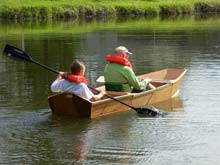 |
Now, what if the middle went to 6 feet and the stern 5-1/2 feet and the bow 5 feet?!
***** |

